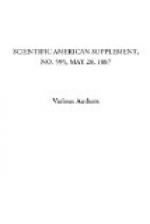Dr. Russell performed the interesting experiment of drawing off the liquid from the bamboo stem and allowing it to stand in stoppered bottles. A “whitish, cottony sediment” was formed at the bottom, with a thin film of the same kind at the top. When the whole was well shaken together and allowed to evaporate, it left a residue of a whitish brown color resembling the inferior kinds of tabasheer. By splitting up different joints of bamboo Dr. Russell was also able to satisfy himself of the gradual deposition within them of the solid tabasheer by the evaporation of the liquid solvent.
In 1791, Mr. James Louis Macie, F.R.S. (who afterward took the name of Smithson), gave an account of his examination of the properties of the specimens of tabasheer sent home by Dr. Russell (Phil. Trans., vol. lxxxi., 1791, p. 368). These specimens came from Vellore, Hyderabad, Masulipatam, and other localities in India. They were submitted to a number of tests which induced Mr. Macie to believe that they consisted principally of silica, but that before calcination some vegetable matter must have been present. A determination of the specific gravity of the substance by Mr. Macie gave 2.188 as the result. Another determination by Mr. Cavendish gave 2.169.
In this same paper it is stated that a bamboo grown in a hot-house at Islington gave a rattling noise, and on being split open by Sir Joseph Banks yielded, not an ordinary tabasheer, but a small pebble about the size of half a pea, externally of a dark brown or black color, and within of a reddish brown tint. This stone is said to have been so hard as to cut glass, and to have been in parts of a crystalline structure. Its behavior with reagents was found to be different in many respects from that of the ordinary tabasheer; and it was proved to contain silica and iron. The specimen is referred to in a letter to Berthollet published in the Annales de Chimie for the same year (October, 1791). There may be some doubt as to whether this specimen was really of the nature of tabasheer. If such were the case, it would seem to have been a tabasheer in which a crystalline structure had begun to be set up.
In the year 1806, MM. Foureroy and Vauquelin gave an account of a specimen of tabasheer brought from South America in 1804 by Humboldt and Bonpland (Mem. de l’Inst., vol. vi., p. 382). It was procured from a species of bamboo growing on the west of Pichincha, and is described as being of a milk white color, in part apparently crystalline in structure, and in part semi-transparent and gelatinous. It was seen to contain traces of the vegetable structure of the plant from which it had been extracted. On ignition it became black, and emitted pungent fumes.
An analysis of this tabasheer from the Andes showed that it contained 70 per cent. of silica and 30 per cent. of potash, lime, and water, with some organic matter. It would, perhaps, be rash to conclude from this single observation that the American bamboo produced tabasheer of different composition from that of the Old World; but the subject is evidently one worthy of careful investigation.




